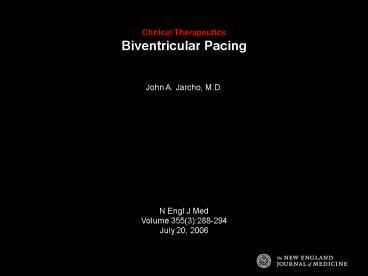Clinical Therapeutics Biventricular Pacing - PowerPoint PPT Presentation
1 / 6
Title:
Clinical Therapeutics Biventricular Pacing
Description:
He is treated with furosemide, lisinopril, and carvedilol. ... examination, his furosemide dose should be increased and his doses of lisinopril ... – PowerPoint PPT presentation
Number of Views:280
Avg rating:3.0/5.0
Title: Clinical Therapeutics Biventricular Pacing
1
Clinical Therapeutics Biventricular Pacing
John A. Jarcho, M.D.
N Engl J Med Volume 355(3)288-294 July 20, 2006
2
Case Vignette
- A 55-year-old man who had had an anterior-wall
myocardial infarction six months previously is
admitted with an exacerbation of congestive heart
failure. - An electrocardiogram shows sinus rhythm with a
left bundle-branch block an echocardiogram
demonstrates a left ventricular ejection fraction
of 25 percent. - He is treated with furosemide, lisinopril, and
carvedilol. - However, during an office visit three months
later, he reports persistent shortness of breath
with mild exertion. - He is referred to a cardiologist, who recommends
implantation of a biventricular pacemaker.
3
Outline
- The Clinical Problem
- Pathophysiology and Effect of Therapy
- Clinical Evidence
- Clinical Use
- Adverse Effects
- Areas of Uncertainty
- Guidelines
- Recommendations
4
The Cardiac Conduction System and Biventricular
Pacing
Jarcho J. N Engl J Med 2006355288-294
5
Recommendations
- The patient described in the vignette meets all
the recommended criteria for CRT he has an
ischemic cardiomyopathy with an LVEF of 35
percent or less and sinus rhythm with a left
bundle-branch block (by definition, with a QRS
interval of at least 120 msec). - I would make certain that his medical therapy is
optimal. - If he has any evidence of volume overload on
physical examination, his furosemide dose should
be increased and his doses of lisinopril and
carvedilol should be increased to the maximum
tolerated (or to a maximum of 40 mg once daily
and 25 mg twice daily, respectively).
6
Recommendations
- If he remains symptomatic (NYHA class III or IV)
despite this regimen, he should receive a
biventricular pacemaker. - Since this patient also satisfies criteria for
the implantation of a cardioverterdefibrillator,
he should receive a device with both capabilities.

